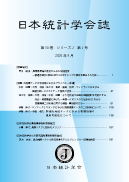Volume 50, Issue 1
Displaying 1-7 of 7 articles from this issue
- |<
- <
- 1
- >
- >|
Article
-
Article type: research-article
2020Volume 50Issue 1 Pages 1-45
Published: September 30, 2020
Released on J-STAGE: December 10, 2020
Download PDF (12139K)
Special Section: Privacy Protection for Big Data
-
Article type: research-article
2020Volume 50Issue 1 Pages 47-80
Published: September 30, 2020
Released on J-STAGE: December 10, 2020
Download PDF (1901K) -
Article type: research-article
2020Volume 50Issue 1 Pages 81-108
Published: September 30, 2020
Released on J-STAGE: December 10, 2020
Download PDF (2942K) -
Article type: research-article
2020Volume 50Issue 1 Pages 109-138
Published: September 30, 2020
Released on J-STAGE: December 10, 2020
Download PDF (1107K) -
Article type: research-article
2020Volume 50Issue 1 Pages 139-166
Published: September 30, 2020
Released on J-STAGE: December 10, 2020
Download PDF (3469K)
Special Topic: The JSS Prize Lecture
-
Article type: research-article
2020Volume 50Issue 1 Pages 167-190
Published: September 30, 2020
Released on J-STAGE: December 10, 2020
Download PDF (964K)
Special Topic: The JSS Ogawa Prize Lecture
-
Article type: research-article
2020Volume 50Issue 1 Pages 191-204
Published: September 30, 2020
Released on J-STAGE: December 10, 2020
Download PDF (762K)
- |<
- <
- 1
- >
- >|
